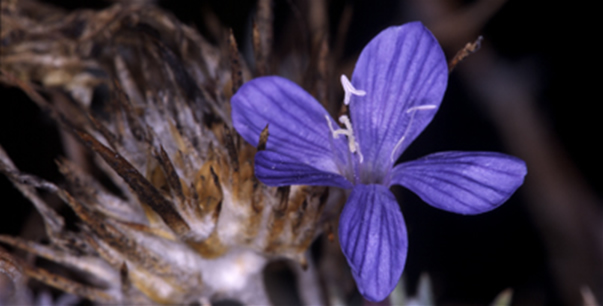A Decade of Research
Scientists Work to Determine Whether Endangered Woolly Star Is Surviving Upheavals in its Specialized Habitat near the Santa Ana River
March 20, 2007
By Russ Hudson
Now scientists can really see what the Santa Ana River Woolly Star has been up to.
More than a decade’s worth of data has been collected on the low-growing shrub with purple flowers — one of the state’s most endangered plants — and data analysis is in full force to see how the shrub is faring in its limited, specialized habitat of sandy, rocky soil, primarily near the Santa Ana River.
“We can analyze the data to determine what trends, if any, exist and how the species is doing in terms of number and population density,” said Amybeth Cohen, associate professor of biological science and director of the Minority Access to Research Careers (MARC) Program. In other words, whether the flowering native shrub that can grow where few other plants of any kind can grow is thriving or declining, possibly toward extinction.
The current phase of the project is funded by a two-year grant totaling $281,816 from Psomas and Associates, a civil engineering firm in Orange County.
Second-year funding of $145,589 has recently received by project directors Cohen; Darren Sandquist, assistant professor of biological science, currently working on another research project in Chile; and C. Eugene Jones, emeritus professor of biological science, who teaches part time. Jones, whose specialty is plant reproductive biology, was one of the early researchers on the project.
With them is post-doctoral researcher and CSUF alumnus Youssef C. Atallah, who received his master’s degree in environmental studies in 2002. He then accepted a fellowship from the German government to work on his doctoral degree there, which he finished in January at the University of Hohenheim.
“We will continue to collect data,” Cohen said. “The study will continue for the next three years,” including final analysis of the data and the management plan. According to the schedule submitted for the grant, the group will collect data through March 2009, with further demographic analysis in May and June of that year. By December 2009 the report should be completed. Meantime, the group will continue to monitor areas where the woolly star should be replanted. That effort, too, will continue for at least the length of the project.
A detailed study of the shrub, which blooms only from June through August, was prompted when the Seven Oaks Dam, a U.S. Army Corps of Engineers flood control project, was first proposed in the 1980s. In the event of a 50-year flood, the dam is designed to lessen the threat to Orange County by half.
The woolly star has been on the list of the 10 most endangered plant species in California. Dam construction in the area could mean its extinction, Jones noted.
“The problem with flood control is that there is no longer the scouring effect [of rapidly moving water] that removes the non-native species from the area. We are concerned that the plants, which would have normally been eliminated by flooding, will take hold and out-compete the woolly star,” Sandquist explained last June. “There is also a question of how much the lack of flooding has affected the distribution of the plant.
“I know people may not consider endangered plants as part of their local heritage, but they are. That’s the big difference between Hawaii and Southern California. In Hawaii, when we talk about the plant species we are trying to save, most people know about them. When you talk about them here, in California, nobody knows about them,” Sandquist observed. “The Santa Ana River basin is part of what I grew up with — it is part of what I connect with when I think of home.”
While discussing the project in 2001, Jones emphasized the implications for the region and its dwindling population of plant communities in the face of urban encroachment and the implementation of various flood control measures.
“This plant and others will help us determine how our entire ecosystem is being modified. It is a major indication of disappearing river habitats in Southern California,” Jones said.
The shrub is found only within open washes and on some alluvial fans (fan-shaped areas at the bases of canyons where soil has been washed out of the canyons for millennia) above main watercourses. It needs gravelly, sandy soils, as well as rock mounds and boulder fields.
Typically, little grows in such areas where the woolly star can thrive. In fact, the ground cover in such areas is typically less than 50 percent, according to a study done by U.S. Fish and Wildlife Service.
`Three graduate students and 11 undergraduates are helping the three educators and Atallah. In fact, in the 11 years since the project began in earnest, dozens of students have helped in the research and at least 10 have produced master’s theses based on various aspects of the research.



